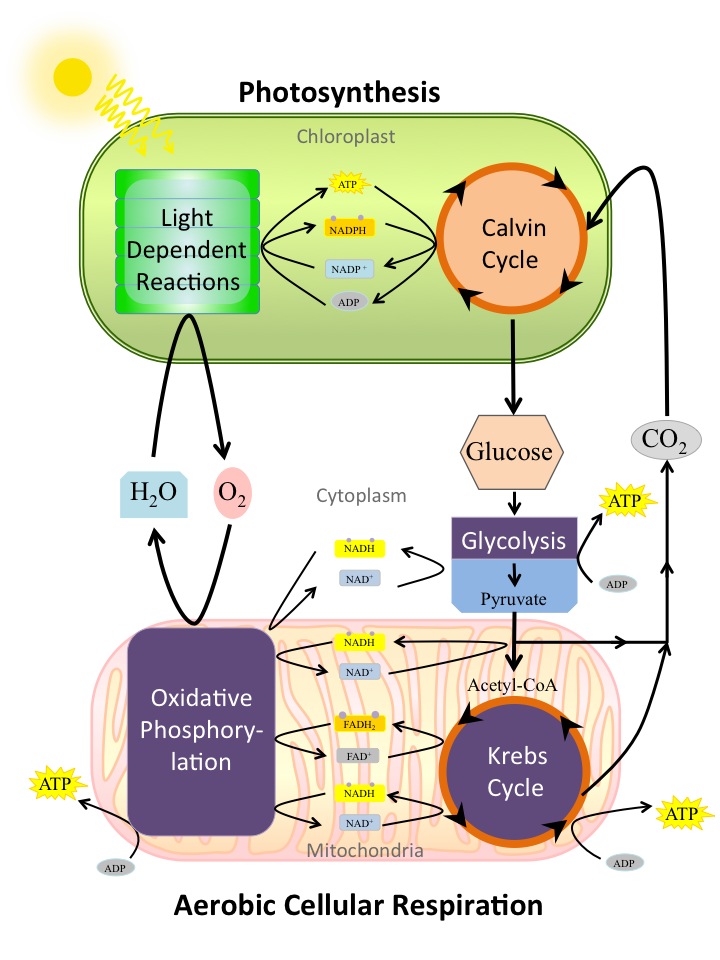| << Chapter < Page | Chapter >> Page > |
Another factor that affects the yield of ATP molecules generated from glucose is the fact that intermediate compounds and electron carriers in these pathways are used for other purposes. Glucose catabolism connects with the pathways that build or break down all other biochemical compounds in cells, and the result is that some metabolites (e.g. pyruvate) are shuttled off for other purposes. Additionally, sugars other than glucose are fed into various steps in the glycolytic pathway for energy extraction. The five-carbon sugars that form nucleic acids are made from intermediates in glycolysis. Certain nonessential amino acids can be made from intermediates of both glycolysis and the Krebs cycle. Lipids, such as cholesterol and triglycerides, are also made from acetyl-CoA, and both amino acids and triglycerides are broken down for energy, feeding into these pathways at various places. NADH is used by other redox reactions in cells, which means that not all of the high energy electrons liberated from glucose are used in oxidative phosphorylation. So the tidy pictures above don't really reflect the complexity of metabolism in a living cell. So the relationship between glucose breakdown and ATP production is like all relationships: "It's complicated."
As you may have noticed, the substrates of aerobic cellular respiration are the products of photosynthesis, and the substrates of photosynthesis are the products of aerobic cellular respiration (
[link] ). These two processes are interdependent; they have been evolving with one another for a very long time and are important components of the carbon cycle and obviously the flow of energy. In this section, we will take a closer look at the codependency of photosynthesis and cellular respiration.

The first point of interaction is the cycling of water and oxygen. During photosynthesis, oxygen gas is produced and the source of the oxygen atoms is the reactant water. The oxygen is formed in the initial step of photosynthesis, when photosystem II splits a water molecule into oxygen gas, hydrogen ions and electrons. In the light dependent reactions on the thylakoid membrane, light energy is absorbed and transferred to ATP and NADP. The light energy is transferred to chemical energy during this process. In aerobic cellular respiration, the roles are reversed: oxygen is the reactant, and water is the product. The aerobic cellular respiration process uses oxygen in the final (not initial) step, when it merges (rather than splitting) with the electrons and hydrogen ions during oxidative phosphorylation. The cycling of water and oxygen between photosynthesis and aerobic cellular respiration is the source of electrons that harvest, store and transfer energy.
Another product of photosynthesis is Glucose (carbohydrate). In the Calvin cycle, carbohydrates are produced by fixing carbon dioxide (reactant) and by adding energy from ATP and NADPH. During aerobic cellular respiration, NADH and FADH 2 capture the energy stored in glucose (reactant). The captured energy in NADH and FADH 2 is then used during oxidative phospholrylation to produce ATP. This process of energy capture also releases a waste product - carbon dioxide. So energy from the sun is used to make glucose from CO 2 , which is a nutrient for the plant. The product of photosynthesis (glucose) contains that nutrient AND the energy derived from sunlight; glcuose is thus a high energy nutrient for heterotrophic organisms. These organisms release the nutrient as CO 2 and use some of the energy to do cellular work. Other energy is lost as heat. It should be obvious that nutrients cycle between autotrophs and heterotrophs, while energy moves in a one-way direction from autotrophs to heterotrophs.
Photosynthesis and aerobic cellular respiration are codependent; they rely upon use each other’s products and byproducts and are essentially the opposites of each other. Neither process can happen without the other because if there is no carbon dioxide, photosynthesis cannot proceed; and if there is no oxygen, aerobic cellular respiration cannot proceed. The exergonic reactions of cellular respiration (glycolysis, Kreb’s cycle and oxidative phosphorylation) mirror the energonic reactions of photosynthesis (Light Dependent Reactions and Calvin cycle). As we learned on the ecosystem level, nutrients cycle and energy flows. The same is true on the cellular level: nutrients cycle and energy flows.

Notification Switch
Would you like to follow the 'Principles of biology' conversation and receive update notifications?